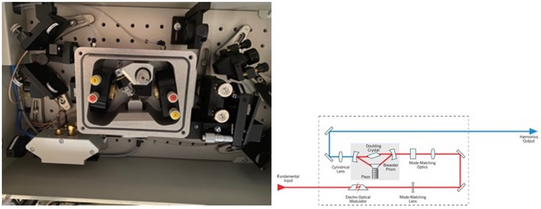Single-frequency laser system with spectral range from 220 to 2200 nm
Experimentelle Physik 2, laboratory CP-E1-176
The optical properties of the semiconductor structures are controlled by excitons created near the band edge. A tunable continuous wave (cw) laser in the spectral range from deep UV up to infrared radiation is suitable for any band gap energy of large variety of semiconductor structures.
The flagship of the continuous wave spectroscopy measurements is the actively stabilized Titanium:sapphire Ring Laser Matisse CS from Sirah. The laser system is a fully automated and compact single frequency tunable ring laser featuring a completely sealed, alignment-free cavity with hands-free operation, unrivalled power, and the ultimate narrow linewidth with low noise output which is ideal for study of several phenomena in quantum physics. Due to its unprecedented tuning range (from 220 to 2200 nm) and narrow line width it is perfectly suitable for high resolution photoluminescence spectroscopy, spin-flip Raman spectroscopy, or optical orientation measurements.
The system is mainly comprised of three elements: A tunable cw single-mode Ti:Sa laser, a Wave Train (for second harmonic generation SHG) and a Mix Train (for sum frequency mixing (SFM) or difference frequency mixing (DFM)).
Specifications:
- Average power: 2 to 6 W (690 – 1050 nm); SHG 0.1 to 1 W (220 – 490 nm); SFM 1 to 2.5 W (490 – 690 nm); and DFM 0.05 to 0.4 W (1050 – 2200 nm)
- Wavelength: 220 to 2200 nm
- Beam radius: 0.4 – 0.5 mm
- Actively stabilized
- With intracavity EOM
- Narrow linewidth < 50 kHz (or < 2ueV)
Applications:
- High resolution PL spectroscopy
- Spin-flip Raman spectroscopy
- Optical orientation
- Quantum physics

Actively stabilized Titanium:Sapphire Ring Laser Matisse CS from Sirah
In the tunable Matisse CS a titanium-doped sapphire (Ti3+:sapphire, sometimes TiSa laser) is used as transition-metal-doped gain medium. The Ti:sapphire crystal, is positioned between two curved mirrors for forming a tight focus in the crystal, with pump light injected through one dichroic mirror. The laser crystal is pretty small with an optical path length of only a few millimeters for pump and laser radiation. Additional components such as piezo driven-mirrors and optical elements such as a motor driven thin Ethalon and a motor driven birefringent filter are installed for precise wavelength tuning.
Laser operations are fully automated via a unique LV interface allowing systems to be controlled, updated and maintained.

The WaveTrain: Powerful tool used for efficient and stable second harmonic generation of the single-frequency cw Matisse laser. It is based on a low-loss, ultra compact enhancement cavity using a patented triangle-shaped ring resonator. A temperature stabilized nonlinear crystal generates the second harmonic of the enhanced fundamental radiation. The phase-matching angle of the crystal can be manually tuned in order to reach more than 50nm. Equipped with a large set of nonlinear crystals the wavelength range from UV to visible green is fully covered. The length of the resonator cavity is stabilized by a pound-Drever-Hall locking scheme for stable second harmonic generation.

The MixTrain: In this unit the frequency of two cw-lasers are combined by quasi-phase matching in periodically poled crystals (sum- or difference frequency mixing). One of the lasers is the tunable Ti:sapphire Matisse laser while the other laser is a powerful fixed wavelength fiber laser. The system is equipped with a motor controlled translation stage for changing the period of the crystal and a temperature stabilized oven capable of heating up to 180°C allowing for gapless changing of the wavelength.

The equipment is funded by the DFG (Deutsche Forschungsgemeinschaft) via the project INST 212/451-1 (M. Bayer) for the Major Research Instrumentation.
Contact persons for collaboration:
Dr. Dennis Kudlacik dennis.kudlaciktu-dortmundde
Dr. Natalia Kopteva natalia.koptevatu-dortmundde
Prof. Dr. Dmitri R. Yakovlev dmitri.yakovlevtu-dortmundde



